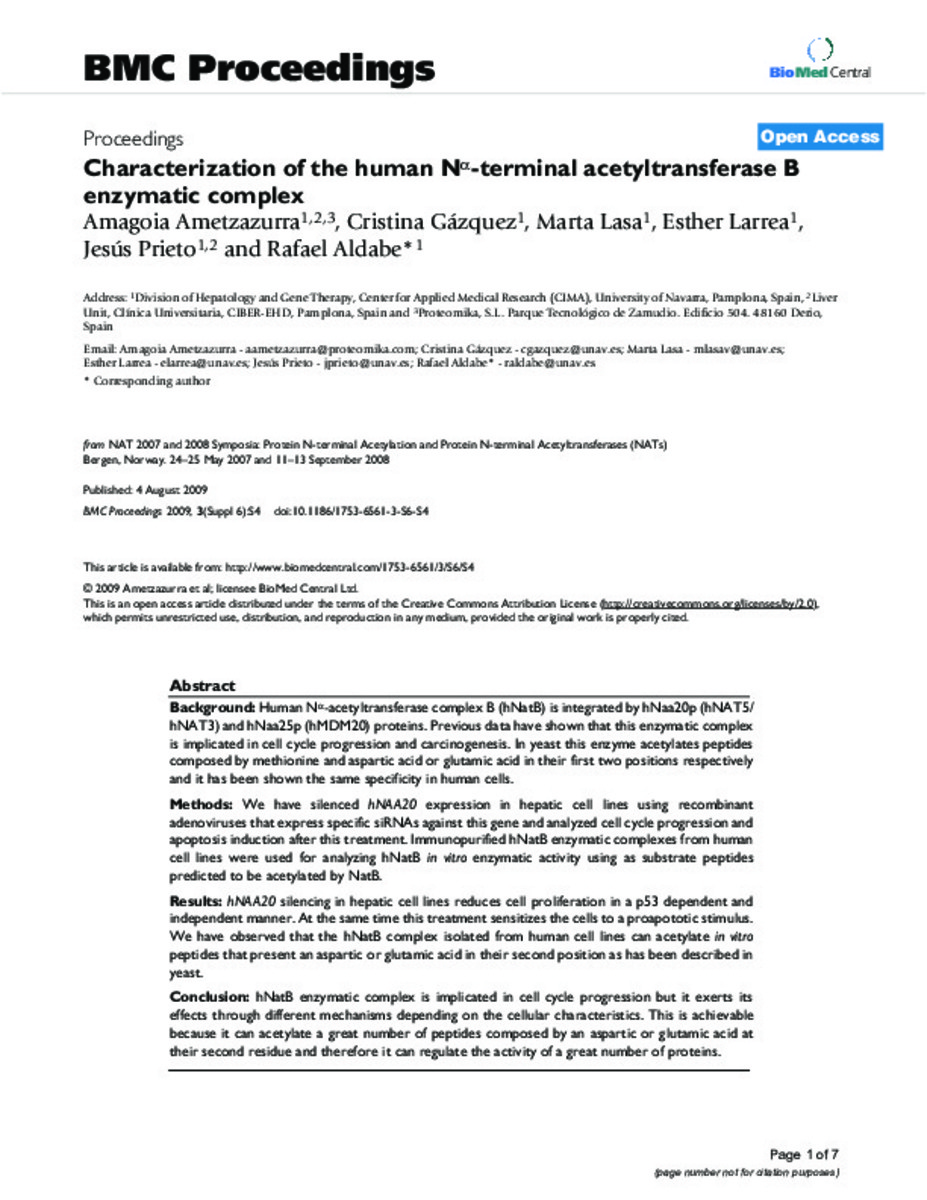Full metadata record
| DC Field | Value | Language |
|---|---|---|
| dc.creator | Ametzazurra, A. (Amagoia) | - |
| dc.creator | Gazquez, C. (Cristina) | - |
| dc.creator | Lasa, M. (Marta) | - |
| dc.creator | Larrea, E. (Esther) | - |
| dc.creator | Prieto, J. (Jesús) | - |
| dc.creator | Aldabe, R. (Rafael) | - |
| dc.date.accessioned | 2012-10-08T11:12:22Z | - |
| dc.date.available | 2012-10-08T11:12:22Z | - |
| dc.date.issued | 2009 | - |
| dc.identifier.citation | Ametzazurra A, Gazquez C, Lasa M, Larrea E, Prieto J, Aldabe R. Characterization of the human Nalpha-terminal acetyltransferase B enzymatic complex. BMC Proc 2009 Aug 4;3 Suppl 6:S4. | es_ES |
| dc.identifier.issn | 1753-6561 | - |
| dc.identifier.uri | https://hdl.handle.net/10171/23323 | - |
| dc.description.abstract | BACKGROUND: Human Nalpha-acetyltransferase complex B (hNatB) is integrated by hNaa20p (hNAT5/hNAT3) and hNaa25p (hMDM20) proteins. Previous data have shown that this enzymatic complex is implicated in cell cycle progression and carcinogenesis. In yeast this enzyme acetylates peptides composed by methionine and aspartic acid or glutamic acid in their first two positions respectively and it has been shown the same specificity in human cells. METHODS: We have silenced hNAA20 expression in hepatic cell lines using recombinant adenoviruses that express specific siRNAs against this gene and analyzed cell cycle progression and apoptosis induction after this treatment. Immunopurified hNatB enzymatic complexes from human cell lines were used for analyzing hNatB in vitro enzymatic activity using as substrate peptides predicted to be acetylated by NatB. RESULTS: hNAA20 silencing in hepatic cell lines reduces cell proliferation in a p53 dependent and independent manner. At the same time this treatment sensitizes the cells to a proapototic stimulus. We have observed that the hNatB complex isolated from human cell lines can acetylate in vitro peptides that present an aspartic or glutamic acid in their second position as has been described in yeast. CONCLUSION: hNatB enzymatic complex is implicated in cell cycle progression but it exerts its effects through different mechanisms depending on the cellular characteristics. This is achievable because it can acetylate a great number of peptides composed by an aspartic or glutamic acid at their second residue and therefore it can regulate the activity of a great number of proteins. | es_ES |
| dc.language.iso | eng | es_ES |
| dc.publisher | BioMed Central | es_ES |
| dc.rights | info:eu-repo/semantics/openAccess | es_ES |
| dc.subject | Protein N-terminal Acetylation | es_ES |
| dc.subject | Protein N-terminal Acetyltransferases (NATs) | es_ES |
| dc.title | Characterization of the human Nalpha-terminal acetyltransferase B enzymatic complex | es_ES |
| dc.type | info:eu-repo/semantics/article | es_ES |
| dc.relation.publisherversion | http://www.biomedcentral.com/1753-6561/3/S6/S4 | es_ES |
| dc.type.driver | info:eu-repo/semantics/article | es_ES |
Files in This Item:
Statistics and impact
Items in Dadun are protected by copyright, with all rights reserved, unless otherwise indicated.






